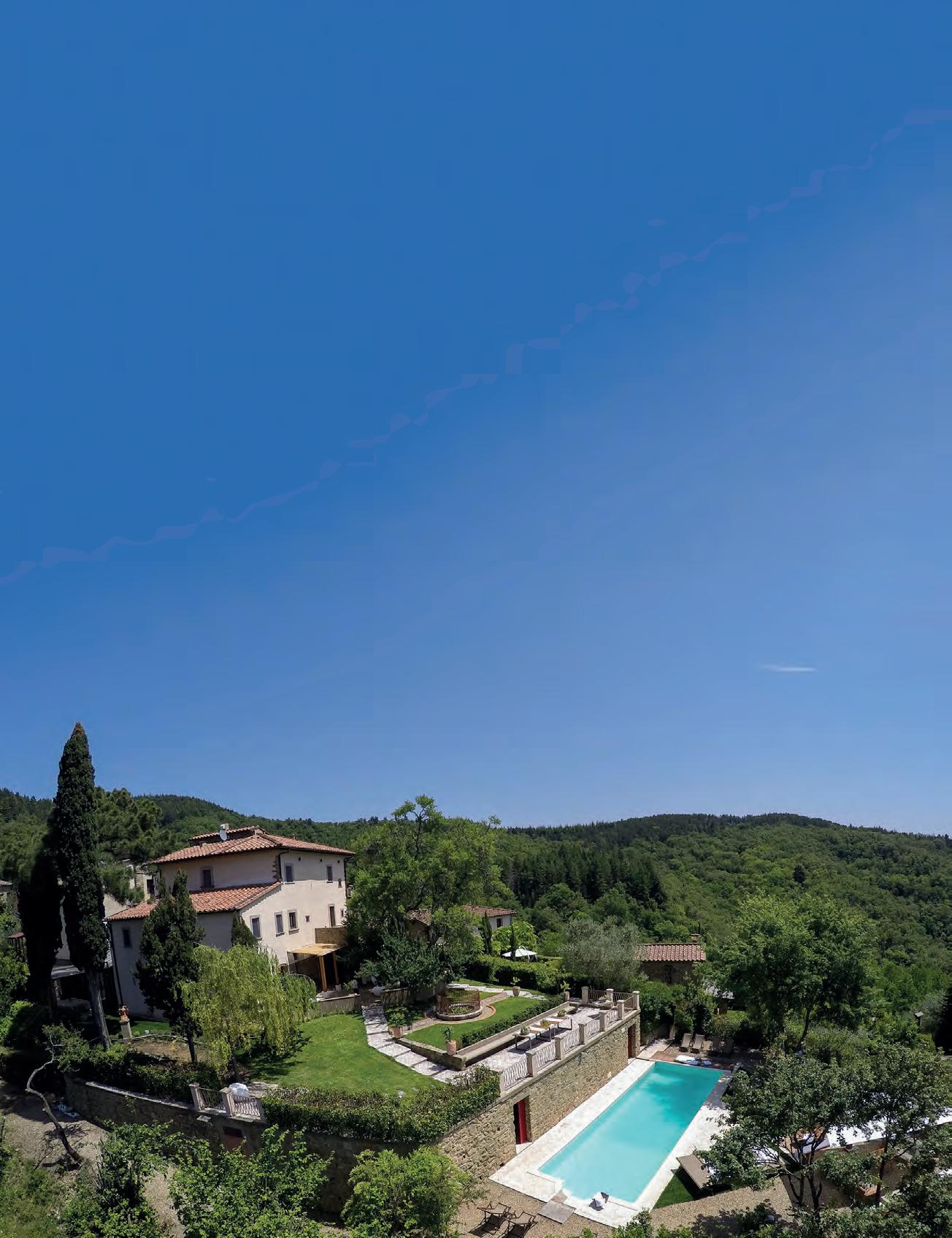
11 minute read
HEARTS AND MINDS
H E A R T S & M I N D S
AN ANCIENT VILLA IN THE TUSCAN COUNTRYSIDE PROVIDES THE PERFECT PLACE TO REACQUAINT WITH OLD FRIENDS
Advertisement
Words: Doug McKinlay
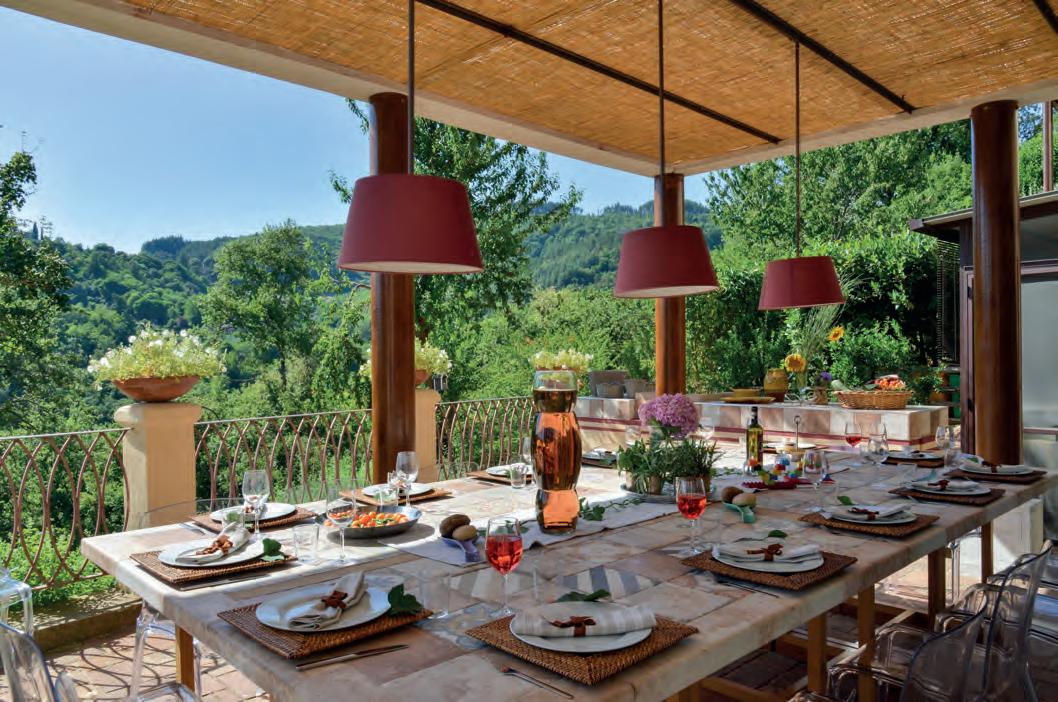
Not long ago, if someone suggested a half-term holiday with two other families, I would have insisted on plan B – without even knowing what plan B was; I’d rather eat broken glass than do that again. I learned the perils of holidaying with other couples and their children the hard way. A day at the beach ended with upturned tables, smashed plates, thrown food, DEFCON 1-level tantrums, and an unholy row on a pedalo with our friends vowing to divorce each other as soon as they got home.
The idea of doing it again, albeit with different couples and their children, filled me with dread. That was my state of mind as our flight from London touched down at Pisa airport on the Italian peninsula.
Ahead of us were four days of villa life and exploration of the Tuscan countryside, which, all going to plan, would involve a vineyard excursion, or two, to sample some of the region’s renowned Chianti. As well as myself and my partner, Jane, our 12-year-old son, Charlie, and his pal Edward, there were old friends Dawn and Peter with their two girls, Hannah, 17, and 10-year-old Megan; and new friends Jacob and his partner Renate, both ex-pats living in Barcelona.
From the off, it was obvious that this was going to be a very different experience to our last attempt at shared holidaymaking. Everyone was much more laid back, and crucially, there was no evidence of impending marital Armageddon. The kids were fun and active, taking a genuine interest in the plans we put together.
If a house can have a life, then few have older bones than the Villa Albizi. It’s part of a small cluster of buildings in the Tuscan hills dating back almost 1,000 years. Once a remote staging post on an ancient Roman road, the hamlet of the Borgo Montefienali was all but abandoned in the 13th century. Over hundreds of years it was lost to the encroaching forest, deleted from existing maps, its history all but forgotten.
But at the turn of the millennium, enthusiastic walker Alessandro Polvani, director of local building contractors Germana Construction, stumbled across
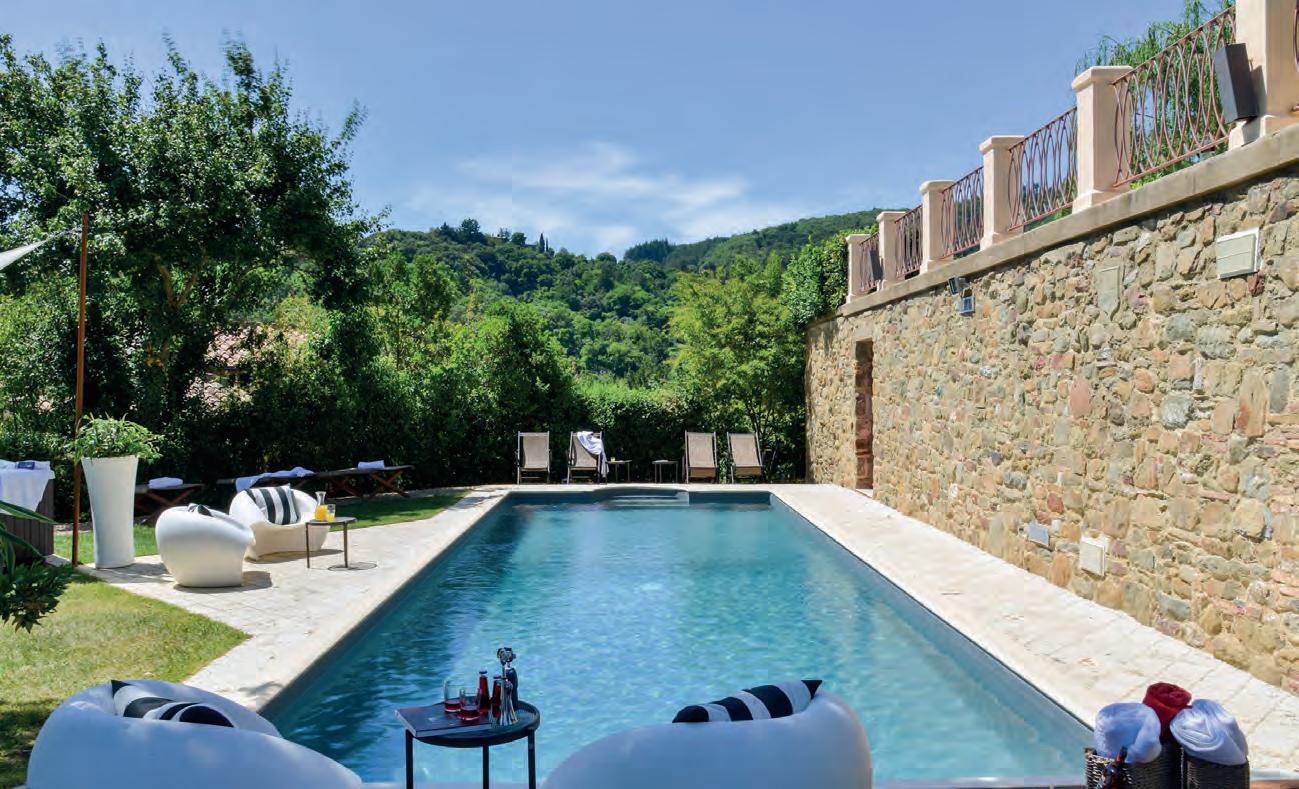
the remains of the hamlet, and instantly saw the potential.
Since 2000, Alessandro, along with his son Thomas and daughter in-law Ilaria Pianigiani, has painstakingly restored the hamlet and its main house, the Villa Albizi Montefienali. “The last occupant of these buildings was a shepherd, and he fled 40 years ago,” says Thomas. “In the four decades since, nature took its toll. All that was left of the buildings were the outer stone walls, the window openings like black eyes. The original plants and cultivation were gone, lost to a thick green mantle of weeds. All that remained of the ancient landscaping was a single cypress tree, marking the entrance to the ruins of a church dedicated to San Domenico.”
With time, money and exquisite taste, the hamlet has been brought back to life; the crowning achievement, the 500 sq m villa. Along with a pool and hot tub, there is a small workout room and a sauna.
Ilaria and Thomas greeted us as if we were old friends. While the kids played in the pool, the couple gave us a tour of the villa and grounds. The stonework reminds you of the Cotswolds. There is a slight honey-toned colour to it. But it’s more than that, it’s the craftsmanship. Every piece is different and slotted perfectly into its neighbour, like a giant vertical jigsaw puzzle. There is a natural fit with the surrounding environment, too, the restoration taking inspiration from the steep hills and vast oak forests of the Chianti region.
“We wanted to rebuild the hamlet and the villa in the old ways,” says Thomas. “We used local stone and methods. These old houses are becoming so rare now. They are so expensive to renovate but we felt like we needed to save this place.”
The villa’s interior also got the goldstar treatment. Here, Ilaria is firmly at the helm. Her choice of decor and colour again reflect the region. Her love of folk art and local crafts is evidenced in every room; from the padded armchairs, with hand-painted patterns, to the custommade beds, to the exquisite carpets. Every room – and there are a lot of rooms – shows this connection to the villa’s past and traditions of Tuscany. It has so many comfortable small snugs, perfect if you want to read in isolation.
The villa is a 45-minute drive from the medieval city of Siena, said to be founded by Senius and Aschius, two
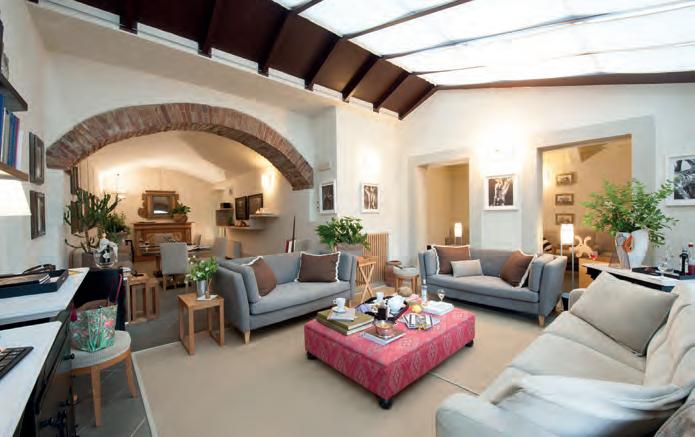
sons of Remus and thus nephews of Romulus, Rome’s two namesakes. Although the city can get crowded, it’s so heartbreakingly beautiful that it’s worth the effort. The architecture is something out of a Botticelli painting, so tactile and warm.
Time was passing quickly, as it always does when everything is going well. On day three, while Peter, Jacob and Renate opted for a lazy morning with the kids, Jane, Dawn and I decided on a vineyard tour. Less than an hour away by car is La Tenuta, a 1,000-hectare estate of rolling hills, lush green forests and ancient cypress trees. The estate is divided into blocks, each growing different grapes for its six wonderful varieties of wine (the Chianti Classico Riserva the best in my opinion).
Sadly, the end was in sight. We had one more evening in the villa, one more meal, a few more bottles of Chianti. What to do when time is limited in such surroundings? We decided to introduce the kids to Monty Python’s Life of Brian on the large-screen television, then played a raucous game of Sardines.
It was time to go. Jacob and Renate headed to Florence while the rest of us made our way to Pisa, stopping for lunch in San Gimignano, with its medieval skyscrapers. In a few short hours we would be home, our Tuscan experience drifting into happy memory.
If nothing else, the trip proved to me that shared holidays are doable, they just need the right combination of people, location and attitude. Villa Ablizi provided the location, which in turn helped with the attitude. As for the people? I’m pleased to report that everyone remains happily married.
Tuscany Now & More offers seven nights at Villa Albizi from £5,464 per week based on 16 people sharing on a self-catering basis. Tuscany Now & More features a range of properties across the region and Italy and can provide private chefs, excursions and other services upon request, 020 7684 8884, tuscanynowandmore.com
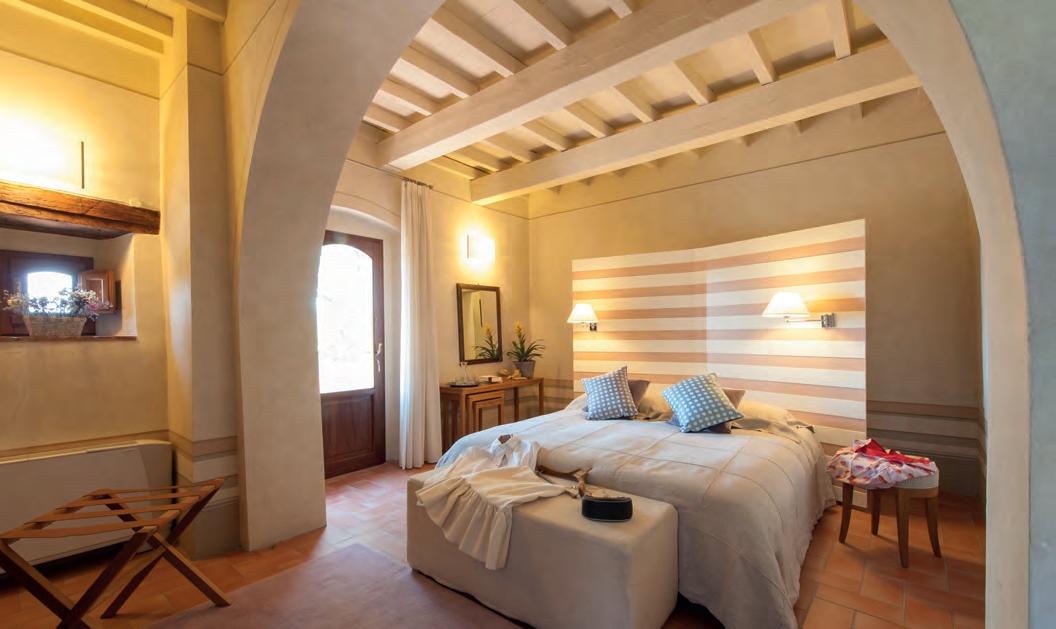
SCHOOL of THOUGHT
WHAT CAN SEPARATED PARENTS DO IF THEY DISAGREE ON WHICH SCHOOL TO SEND THEIR CHILDREN? In partnership with litigation specialists Stewarts

There are many factors to consider when selecting a school for your children: location, Ofsted ratings, reputation, extracurricular opportunities, sports facilities – the list goes on. For separated parents, there can be further things to think about. How will the school work in terms of childcare agreements? Can both parents get to the school easily in case of an emergency? In the case of private schools, will there be a financial impact of choosing one school over another?
If separated or divorced parents are unable to agree on just one of these considerations, things can start to get complicated. If you cannot come to a consensus on which school is right for your child or children, what happens next?
THIRD STEP: COURT
FIRST STEP: TALK
As with all disagreements, especially those involving the care of a child, the best place to start is with an open and honest conversation. Arrange to speak to your ex-partner and/or anyone else that has a parental responsibility for your child or children. Discuss your thoughts, express your concerns, perhaps arrange to visit the schools for yourselves. You might be able to find some common ground, in which case one school may emerge as the preferred choice for both parties. If you’ve tried talking, but are still unable to come to an agreement, what then?
SECOND STEP: MEDIATION

If, after mediation, you’re still unable to arrive at a consensus, then the matter can be taken to court by applying for a Specific Issue Order or a Prohibited Steps Order. A court will only grant these orders if parents have attempted mediation first. “The benefit of taking the matter to court,” says Rosie Stewart, also a Senior Associate in Stewarts’ Divorce and Family team, “is that you end up with a binding decision which will provide both parents, and the child, with a definitive resolution to the conflict. The downside is that court proceedings could get costly. If the matter proceeds all the way to a final hearing there will likely already have been three separate court hearings at a significant cost to both parties. It may also take several months for the court to list a final hearing, which leaves the family in a state of prolonged uncertainty.”
WHAT WILL THE COURT CONSIDER?
“The court’s paramount consideration is the welfare of the child,” says Stewart. “The court must consider what is known as the ‘welfare checklist’ set out in the Children Act 1989. This includes the ascertainable wishes and feelings of the child; the child’s physical, emotional and educational needs; the likely effect on the child of any change in their circumstances; any harm the child has suffered or is at risk of suffering; and how capable each of the parents is of meeting the child’s needs.”
CASE STUDIES
The next step would be to arrange to see a trained family mediator. A third-party specialist would listen to both sides of the argument, and may ask to speak to your child or children (depending on their age), in order to assist you in finding an amicable solution.
“If successful, mediation provides parents with a relatively swift resolution which has been agreed by them rather than imposed on them by the court,” says Trevona Hettiarachchi, Senior Associate in the Divorce and Family team at Stewarts. “Mediation is quicker and significantly less expensive than litigation. It also spares the parents, the wider family and, most importantly, the child, from the stress and conflict of court proceedings.”
With schooling decisions, however, timing tends to be of the essence. Take, for example, entries that rely on 11+ examination results. Typically, there’s a small window between offers being made by the school and the time for acceptance. “Unless both parties are entering mediation in good faith with genuine motivations to resolve the matter,” says Hettiarachchi, “mediation can be used to time out the other parent from seeking a determination by the court.” Even with the best will in the world, mediation can still be unsuccessful. So, what happens then?
“This year,” says Stewart, “I had a case where the educational experience of the child’s older siblings was a factor that the court took into consideration. All four older siblings had been educated at School A. The father wanted the fifth child to go to School A. The mother did not. The court agreed with the father that if the fifth child TOP ROSIE STEWART was the only child in the family not to attend BELOW TREVONA HETTIARACHCHI School A it would set him apart from his siblings in a way that could be harmful to him. I had not come across that line of argument before and thought it interesting.” Says Hettiarachchi: “My most recent experience of a schooling application involved a high-achieving child who was sitting their 11+ examinations and while the parents were able to shortlist the secondary schools of choice, they were unable to agree an order of preference pending offers. In the end, having prepared statements and with a matter of weeks to go until the hearing, the child did not receive an offer for the father’s preferred school, so consented to the mother’s choice. It was technically a ‘win’, but bittersweet as the child was completely aware of the conflict involved.” To discover how Stewarts can help assist you with schooling disputes, or any other family matter, please call 020 7822 8000 or visit stewartslaw.com

Homes &
Interiors
IT’S WHAT’S INSIDE THAT COUNTS
Park Modern, on the edge of Hyde Park, is one of a new breed of super-prime new-builds changing what HNWIs can expect from life in the capital (p.123).











